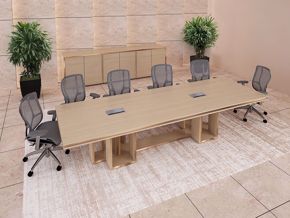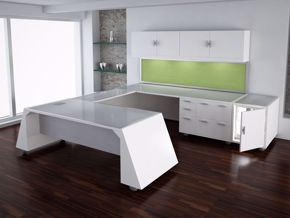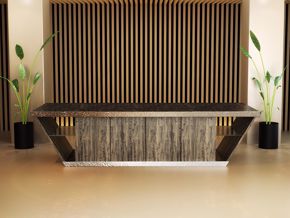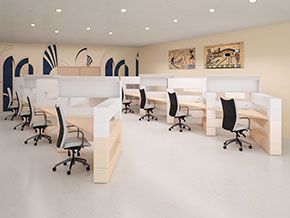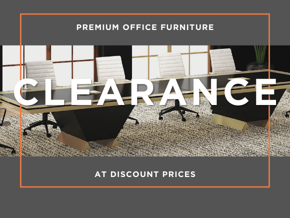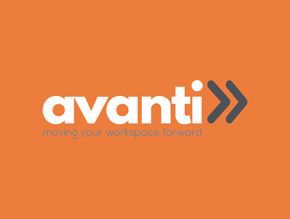Let’s shine some light on the real issues do-it-yourself office designers face when setting out to design their workspaces. A conference room design, for example, seems simple enough…select a conference table you like, or one that fits your budget, put it in the middle of your room, place a few chairs around it, and voilà! You’re done…right?
On second thought, there may be a couple of other things you want to address. You need to get the size right, and maybe the color. That’s not too difficult, either…or is there more?
DIY designers don’t always know which questions to ask.
If you don’t hire a professional designer, DIY designers are left with the task of making a bunch of choices on their own, hoping they haven’t missed anything or screwed up the choices they made. This leaves thoughtful do-it-yourself office designers groping in the dark seeking answers. Often, the unanswered questions—the ones they never thought about asking—are the ones that create OH, S***T moments in the end.
Conference room design may be more important than you think.
Let’s face it. Whether you’ve thought about it in exactly these terms or not, your conference room or meeting space is one of the most important areas in your entire workplace. It’s where you and your customers or clients come together to create new business for your company. It’s where you unite to iron out differences. It’s where team members get together to create ideas and build strategies. It’s the place where you meet with potential vendors, to launch new products and ideas that can propel your business to places you’ve never gone before—and so much more.
Given the importance of all your intended uses, a meeting place that fully supports what you want to accomplish is, without a doubt, something you should think through carefully.
For all these reasons, there are several things your meeting space must do well: look appealing, feel inviting, function well, complement your meetings, and support the company’s image strategy.
- Getting the visual right
Functional details notwithstanding, the first thing that stands out when a visitor looks through a glass wall or enters your conference room doorway is the sheer impact of what they’re seeing. For most of us, what we see is a big part of what we believe to be true. Capitalizing on that first modality (sight) and designing around it can be a great influence strategy. People naturally believe what they see. If you get the visual right, you’re off to a great start. - Making it feel right
I’ve got to believe most do-it yourself office designers never give the first thought to feeling. After all, that touchy-feely stuff has no place in an office environment, right? Wrong—at least when it comes to conference room design. People believe what they see, and support it with what they feel. Creating a conference room that looks great and supports the office environment with the right table, chairs, color scheme, artwork, functional tools, and other elements can bring you a step closer to setting the stage for great visitor expectations. - Getting the sizing right
Balancing size with function is a matter of choosing the right-sized conference table to accommodate the number of people attending your meetings. Get the wrong size table, and some meeting attendees will be standing—or, at the very least, virtually sitting on top of one another. Allowing 30" to 36" per person around the perimeter of the table will allow enough space for comfort. - Getting the right materials for the job
Choosing the right tools for the job is as important in the real world as selecting materials for your conference table. Like anything else, some materials wear better than others, and some table-usage requirements are more rugged than others. Meetings that require machine parts or sample selection may scratch or gouge conference table tops made of softer materials. Most tables in the marketplace come in one material, and possibly one or two colors. If you choose the wrong material for your application, your conference table will look like crap in no time—or fail to leave the impression you had hoped for. - Getting the scale right
Matching conference-table size and shape with the size and shape of the room is a matter of scaling your conference table down from the chair space (and walk space around the perimeter of the table). Getting the scale wrong could visually and physically crowd the room, or cause your table to be lost in a big space. Sometimes, getting it right can mean having your conference table custom-made to get the proper fit for your business. Standard tables may not allow this if they are too big, too small, or disproportionate to the size or shape that works best. At 90 Degree Office Concepts, we feel that having to settle for a certain table size just because that’s the way it comes is not in your best interests. - Choosing the right structure
Just as your choice of food impacts how your body functions, the materials your conference table is made of impact how well it will stay together without wobbling—and how well it will react to moisture, scratching, edge wear, and foot wear. Sitting at a wobbly conference table with prospective clients is not cool. The integrity of your conference table is primarily dependent upon its substrate materials. If your table substrate is made from particleboard, the ability of your table to stay together is dependent upon how well the fasteners hold in those tiny, pressed-together pieces of wood. A house is only as good as its foundation. Most furniture these days is imported. To have it shipped in a cost-effective manner, it must be knocked down flat to save container space, and made from materials that allow high sales volume and fast production. Your furniture is only as good as what’s under the surface—because if the foundation is poor, so is your structure. - Getting the right image for your company
What you put in your conference room reflects the style, attitude, and quality of your company. Furniture choice reflects possibilities. Getting the style, material, and color right is crucial to making the perfect statement about who you are and what your company does. Often, little details can go unnoticed by DIY designers. Tying them all together into one harmonious thought is the idea behind perfect selections for your conference room.
Focusing on your priorities
While it’s important to keep company finances under control, many DIY designers sell short the value of an initial impression in the minds of their customers.
Though many factors are important to great meeting space design, it is crucial to use your personal creativity to develop a plan that fits your company budget while physically expressing the concepts that best suit your company’s ideals and values.
Knowing the right things to do and ask can be a challenge.
It can be challenging to think of everything you need to consider in making your meeting space impressive, comfortable, and functional. For this reason, we at 90 Degree Office Concepts would like to extend an invitation to you. We’d like to answer all your conference room design questions—and ask the ones you may not know to ask.


